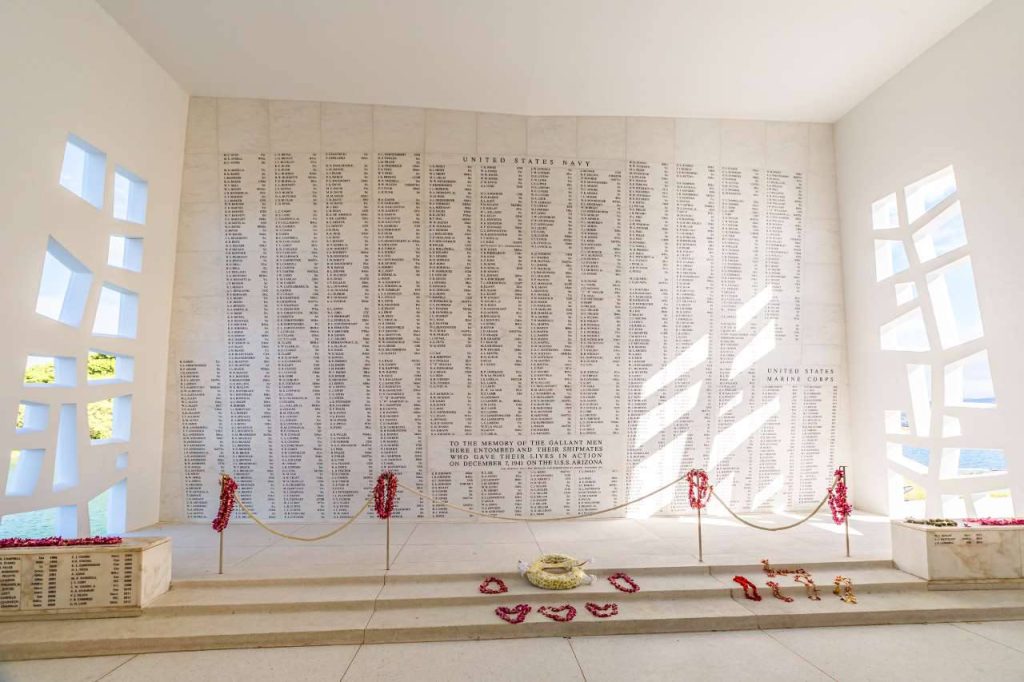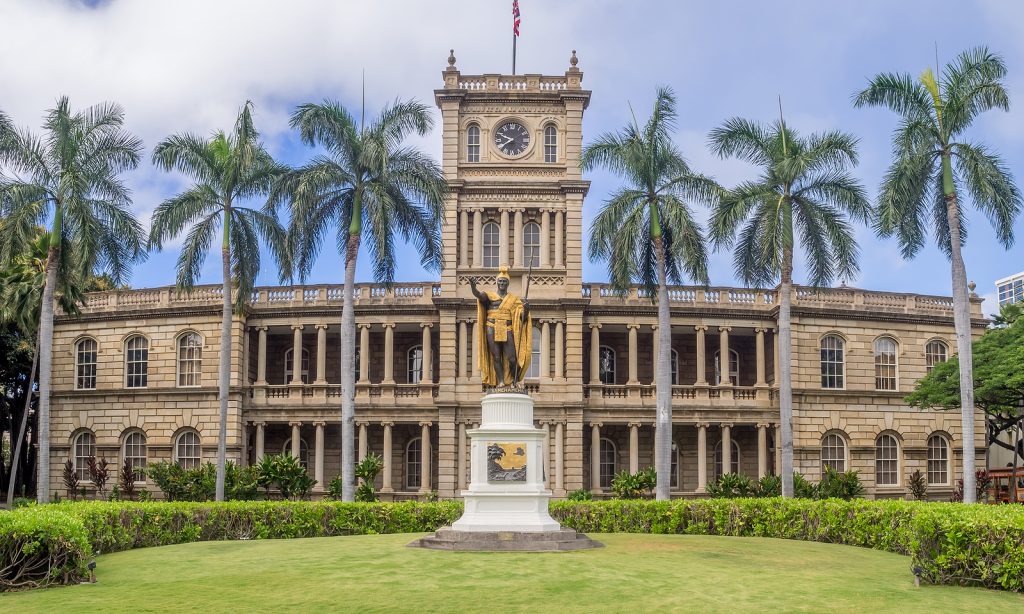Oahu island Tour From Daniel K. Inouye International Airport
Oahu Island Tour From
Daniel K. Inouye International Airport
(Honolulu Airport - HNL)
Oahu Island Tour From Daniel K. Inouye International Airport
Kualoa Ranch

Kualoa Ranch
Oahu, often referred to as "The Gathering Place," offers visitors a unique opportunity to immerse themselves in the vibrant culture, stunning landscapes, and rich history of Hawaii. Touring this iconic island is more than just sightseeing; it's an exploration of the traditions, stories, and natural beauty that define the essence of Hawaii. Each tour on Oahu presents a journey through time, from its ancient Polynesian roots and royal Hawaiian legacy to its pivotal role in modern history.
Travelers can embark on an adventure that takes them from the bustling streets of Honolulu to the tranquil, untouched beauty of the island's more remote regions. In Honolulu, the energy of urban life is perfectly balanced with cultural landmarks like Iolani Palace, the only royal palace in the United States, and the serene Hawaii State Capitol. The history of Hawaiian royalty and governance is deeply interwoven with the area, offering visitors a glimpse into the island's transformation over centuries.
The haunting yet inspiring experience at Pearl Harbor provides an in-depth understanding of the events of December 7, 1941, and their lasting impact on the world. Visitors can reflect on the sacrifices made during World War II as they explore the USS Arizona Memorial, the USS Missouri Battleship, and the exhibits that bring history to life. These sites, nestled along Oahu's southern coastline, draw millions each year, serving as a reminder of resilience and courage.
As tours extend beyond the city, the island's natural splendor takes center stage. The lush green mountains of the Ko'olau Range, cascading waterfalls, and pristine beaches create a breathtaking backdrop for any journey. Travelers often find themselves in awe of Diamond Head, an ancient volcanic crater that offers panoramic views of Waikiki and the Pacific Ocean. Whether hiking its rugged trails or simply taking in its majestic form from afar, Diamond Head stands as a symbol of Oahu's geologic history and enduring allure.
For those seeking tranquility, the North Shore offers a more relaxed pace, where the legendary waves that attract surfers from around the globe meet laid-back local charm. During the winter months, visitors might witness professionals conquering the massive swells at Pipeline and Waimea Bay, a display of both human skill and the ocean's raw power. This area is also a hub for those who wish to explore local art galleries, enjoy farm-to-table dining experiences, and connect with the island's creative spirit.
The journey to Oahu's eastern shores unveils some of the island's most picturesque landscapes, with dramatic cliffs, vibrant coral reefs, and the iconic Makapu'u Point Lighthouse standing as highlights. The region's coastal vistas and clear blue waters invite exploration, whether by snorkeling among tropical fish or simply enjoying the sun's warmth on secluded beaches.
Every Oahu tour, whether steeped in history, cultural exploration, or natural discovery, allows visitors to delve deeper into what makes this island so extraordinary. Guided by the aloha spirit, these experiences often reveal not only the beauty of the land but also the stories and values of the people who call Oahu home. With every turn, Oahu offers a new layer of adventure, connection, and awe, creating memories that remain with visitors long after their journey concludes.
Statue of King Kamehameha
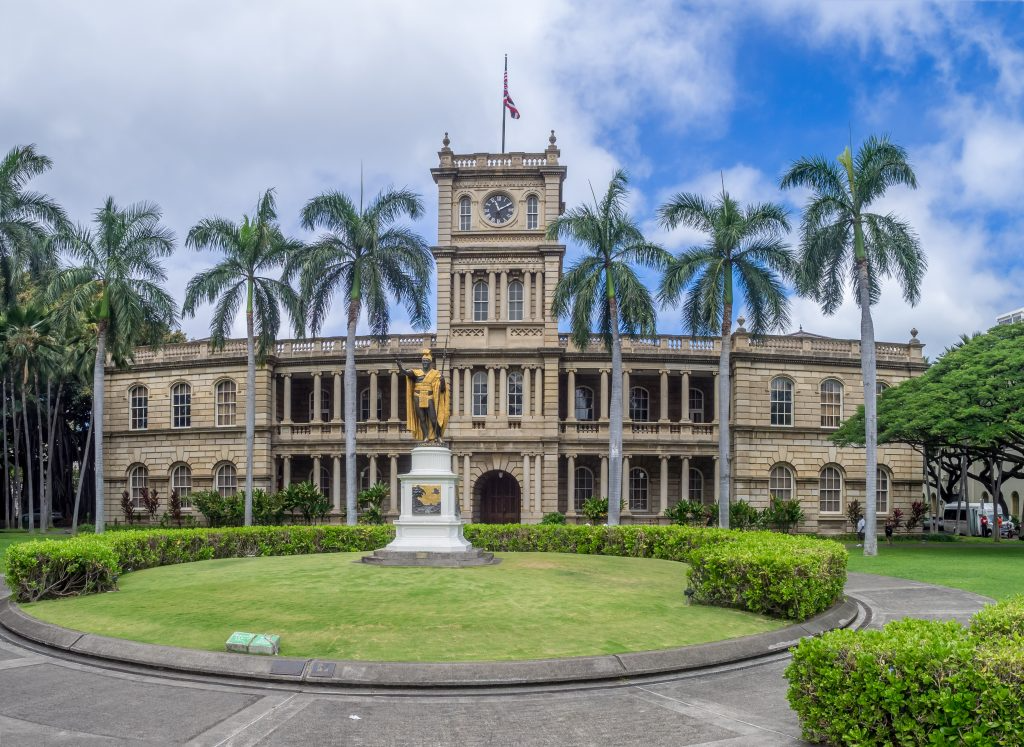
Oahu Island Tour From Daniel K. Inouye International Airport
The statue of King Kamehameha I, standing proudly in front of the Ali'iolani Hale in downtown Honolulu, is one of Hawaii's most iconic landmarks. This regal depiction of the great monarch, known as"Kamehameha the Great," honors his legacy as the unifier of the Hawaiian Islands and a symbol of leadership, resilience, and cultural pride. Draped in a golden cloak and extending his right arm in a gesture of welcome, the statue is a powerful emblem of Hawaiian history and the enduring spirit of its people.
King Kamehameha I, born in 1758, is celebrated for his role in uniting the warring chiefdoms of the Hawaiian Islands into a single kingdom by 1810. His vision of a united Hawaii marked the beginning of a new era, establishing peace and prosperity while fostering trade and diplomatic relations with other nations. Kamehameha's leadership skills, military prowess, and strategic alliances made him one of the most significant figures in Hawaiian history. His legacy is reflected in this remarkable statue, which stands as a tribute to his accomplishments and his profound influence on the islands.
The creation of the statue itself is a fascinating story. Commissioned by the Hawaiian government in the late 19th century, it was designed by American sculptor Thomas Ridgeway Gould. The original statue was cast in Paris and intended to be erected in Honolulu. However, during its journey to Hawaii, the statue was lost in a shipwreck off the Falkland Islands. Undeterred, a second casting was made and successfully shipped to Honolulu, where it was unveiled in 1883 to coincide with King Kamehameha Day, a public holiday established to honor the monarch.
Interestingly, the original statue was later recovered from the ocean, restored, and placed in Kamehameha's birthplace in Kapa'au, North Kohala, on the Big Island. Today, both statues stand as enduring symbols of the king's legacy, with the Honolulu statue serving as a focal point for celebrations and tributes.
The Honolulu statue is adorned with vibrant leis during the annual King Kamehameha Day festivities on June 11. The ceremony, known as the Lei Draping Ceremony, is a moving spectacle that features traditional Hawaiian chants, hula performances, and floral offerings. Towering ropes of fragrant plumeria, orchids, and other tropical blooms are carefully placed around the statue, transforming it into a breathtaking display of aloha and reverence. This tradition not only honors Kamehameha's contributions but also highlights the deep cultural connection between Hawaii's people and their history.
Beyond its historical and cultural significance, the statue is a striking piece of art. Kamehameha is depicted with a commanding presence, wearing a traditional feathered cloak ('ahu 'ula) and helmet (mahiole) that signify his royal status. The golden finish of the statue reflects the sunlight, making it a radiant centerpiece against the backdrop of Ali'iolani Hale and the lush greenery of the surrounding area.
For locals and visitors alike, the statue of King Kamehameha I is a place of reflection and inspiration. It serves as a reminder of Hawaii's rich heritage, the strength of its leaders, and the unity that defines its people. Standing in the presence of this iconic figure is not just a historical encounter—it's a profound connection to the story of Hawaii and the enduring legacy of its greatest king.
Washington Place
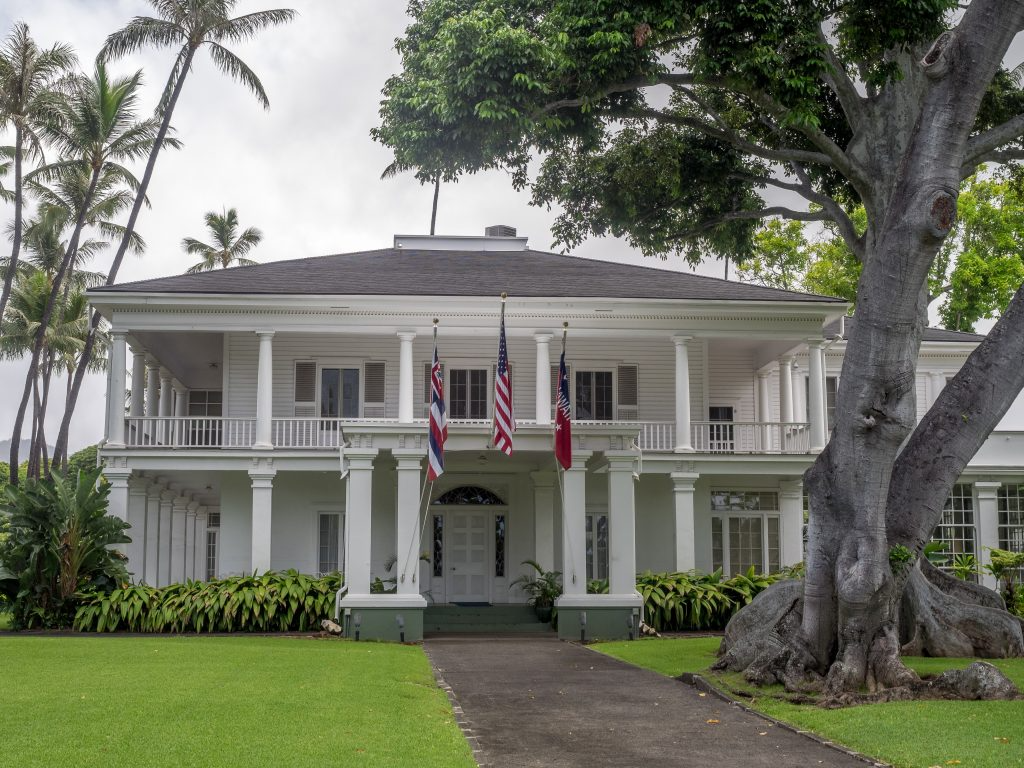
Add Your Heading Text Here
Washington Place, nestled in the heart of Honolulu, is far more than just a stately residence; it is a cherished symbol of Hawaii's history and cultural identity. This historic landmark, which has served as a home for monarchs, governors, and political leaders, stands as a testament to Hawaii's evolving legacy, from its days as a sovereign kingdom to its role as a modern U.S. state.
Constructed in 1847, Washington Place was originally built for Captain John Dominis, a sea captain and businessman. Its grand yet understated architecture reflects the influences of both Western design and Hawaiian sensibilities. The house was later home to Queen Lili'uokalani, Hawaii's last reigning monarch, who resided there before ascending the throne in 1891. For Lili'uokalani, Washington Place was more than a dwelling; it was a sanctuary where she composed music, reflected on her responsibilities, and advocated for the rights and sovereignty of her people.
Washington Place's significance deepened during the political upheaval of the late 19th century. Following the overthrow of the Hawaiian Kingdom in 1893, Queen Lili'uokalani was forced to vacate Iolani Palace and return to Washington Place, where she spent her final years. It was here that she composed her most famous song, "Aloha Oe," a poignant farewell that has since become a universal symbol of love and longing.
In the decades following Hawaii's annexation by the United States, Washington Place transitioned from a royal residence to a center of governance. In 1922, it was designated as the official residence of Hawaii's territorial governors, a role it maintained after statehood in 1959. Over the years, the home became a venue for political decision-making and a site where leaders from around the world were welcomed, embodying Hawaii's unique position as a bridge between East and West.
Despite its political role, Washington Place has retained its connection to Hawaii's cultural heritage. The house has been carefully preserved to honor its royal past, with many rooms restored to reflect the time of Queen Lili'uokalani's residence. Artifacts, furnishings, and photographs tell the story of the people who lived and worked there, offering visitors a glimpse into the personal and public lives of Hawaii's leaders.
In 2002, Washington Place underwent a transformation. A new governor's residence was constructed nearby, allowing the original structure to be repurposed as a museum and cultural site. Today, Washington Place stands as a symbol of Hawaii's resilience and adaptation, welcoming visitors who seek to understand the island's rich history and the figures who shaped its destiny.
Walking through its halls, one cannot help but feel a sense of reverence for the enduring spirit of Hawaii. Washington Place is more than a building; it is a repository of memories, a witness to history, and a beacon of Hawaii's cultural and political journey. Its legacy continues to inspire, reminding all who visit of the island's unique and powerful story.
Hawaii State capital

Add Your Heading Text Here
The Hawaii State Capitol in downtown Honolulu is more than just a seat of government; it is a bold architectural symbol of the islands' unique identity, history, and values. Designed to reflect Hawaii's natural beauty, cultural heritage, and commitment to openness, the Capitol stands as an enduring representation of the state's place within the United States while honoring its indigenous roots and connection to the Pacific.
Completed in 1969, the Hawaii State Capitol was commissioned to replace the aging Iolani Palace as the center of state governance. Its design, crafted by architects John Carl Warnecke and Belt, Lemmon & Lo, breaks from the traditional domed and columned structures typical of American statehouses. Instead, the Capitol's innovative open-air concept mirrors the elements of Hawaii itself, incorporating water, sky, earth, and volcanic symbolism to tell the story of the islands.
The most striking feature of the Capitol is its central open-air rotunda, a space that invites light and air into the heart of the building. The rotunda opens to the sky, symbolizing transparency and the connection between government and the people it serves. Standing beneath this circular void, visitors can feel the gentle breezes and hear the sounds of the city, reminding them of Hawaii's unique environment and interconnected community.
Surrounding the Capitol is a large reflecting pool, representing the Pacific Ocean that envelops the Hawaiian Islands. The water's gentle ripples serve as a reminder of Hawaii's maritime heritage and its role as a crossroads between East and West. The building's structure, with its distinctive columns shaped like coconut palm trunks, further emphasizes the island's natural environment and the importance of agriculture in Hawaiian history.
The Capitol's legislative chambers are another testament to its symbolic design. The House of Representatives chamber is shaped like a volcano cone, while the Senate chamber reflects the dome of the sky. These elements pay homage to Hawaii's volcanic origins and the heavens above, tying the building to both the physical and spiritual foundations of the islands. The interior features local materials such as koa wood, enhancing the connection to Hawaiian resources and craftsmanship.
Beyond its architecture, the Hawaii State Capitol is a place where the stories of Hawaii's people converge. It has been the site of legislative milestones, cultural celebrations, and community gatherings. From debates about environmental preservation to moments of statehood commemoration, the Capitol reflects Hawaii's commitment to addressing contemporary issues while honoring its past.
Visitors to the Capitol are greeted by statues of Queen Lili'uokalani and Father Damien, figures who embody Hawaii's cultural pride and legacy of service. Queen Lili'uokalani's statue, in particular, reminds all who enter the Capitol of the island's journey from monarchy to statehood and the enduring spirit of its people.
The Hawaii State Capitol is not merely a government building; it is a living symbol of Hawaii's identity. Its design, rooted in the natural and cultural elements of the islands, serves as a constant reminder of the state's unique heritage and its aspirations for the future. Whether serving as a space for governance or a destination for reflection, the Capitol continues to inspire all who visit its grounds.
Iolani Palace
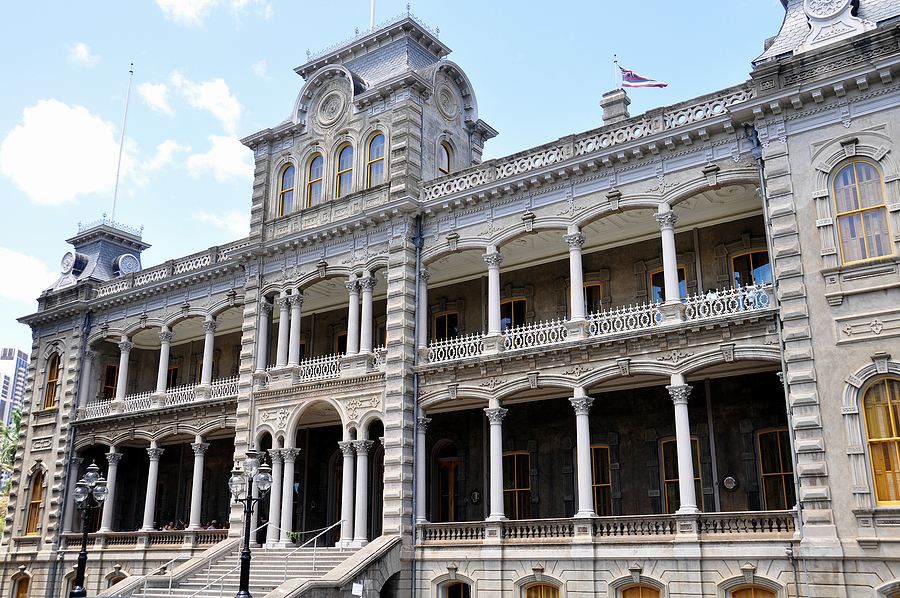
Add Your Heading Text Here
Iolani Palace, nestled in the heart of downtown Honolulu, is a majestic symbol of Hawaii's royal heritage and the resilience of its people. As the only royal palace in the United States, it stands as a testament to the Hawaiian Kingdom's sophisticated monarchy, its embrace of modernity, and its determination to preserve the cultural identity of the islands. This architectural gem, with its elegant grandeur, tells a story of innovation, political transformation, and a deep connection to Hawaii's past.
Constructed in 1882 during the reign of King Kalākaua, Iolani Palace was envisioned as a modern and regal residence befitting Hawaii's monarchs. King Kalākaua, often called the "Merrie Monarch" for his dedication to arts and culture, sought to showcase Hawaii as a progressive and independent nation. The palace was designed in the American Florentine style, blending European influences with Hawaiian sensibilities, and was equipped with cutting-edge features such as electric lighting, indoor plumbing, and a telephone—technological advancements that rivaled the grand palaces of Europe and America at the time.
Beyond its architectural marvels, Iolani Palace served as a vibrant cultural and political hub. It hosted lavish celebrations, diplomatic receptions, and performances that highlighted Hawaii's rich traditions while fostering relationships with foreign nations. The palace was a symbol of the Hawaiian Kingdom's sovereignty and its status as a respected member of the global community.
However, the history of Iolani Palace is also marked by profound challenges. In 1893, Queen Lili'uokalani, the last reigning monarch of Hawaii, was overthrown in a coup orchestrated by American and European businessmen with the support of U.S. military forces. Following the overthrow, the palace was repurposed as the headquarters for the provisional government and later the Republic of Hawaii. Queen Lili'uokalani herself was placed under house arrest in the palace for nearly a year, confined to a second-floor room where she composed songs of heartbreak and hope, including the iconic "Aloha Oe."
For decades, Iolani Palace served as the administrative center for Hawaii's territorial and state governments, its royal legacy largely overshadowed. By the mid-20th century, efforts to restore the palace to its former glory gained momentum, driven by a resurgence of Hawaiian cultural pride. The Friends of Iolani Palace, a dedicated group of volunteers and historians, spearheaded the restoration, carefully recreating the original furnishings, decor, and artifacts to bring the palace back to life.
Today, Iolani Palace stands as a beacon of Hawaiian history and cultural revival. Visitors can walk through its opulent halls, from the grand throne room to the private royal chambers, and immerse themselves in the stories of Hawaii's monarchy. Exhibits showcase artifacts such as the royal crowns, portraits, and ceremonial regalia, offering a glimpse into the lives of the kings and queens who once ruled these islands.
Iolani Palace is more than a historical site—it is a living reminder of Hawaii's journey from monarchy to statehood, and a tribute to the enduring spirit of its people. Its stately presence and poignant history continue to inspire visitors from around the world, serving as a bridge between Hawaii's royal past and its vibrant present.
Magic Island
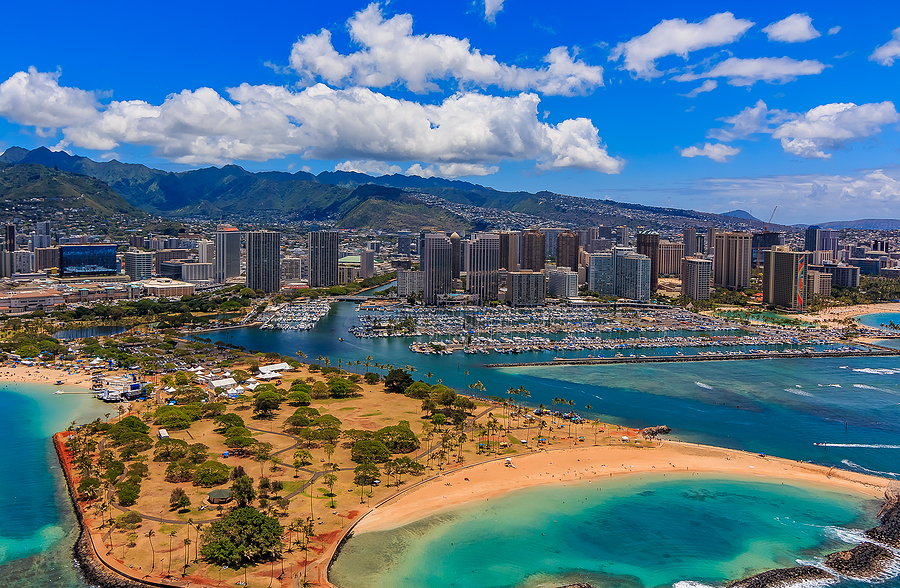
Add Your Heading Text Here
Magic Island, a man-made peninsula that juts out from Ala Moana Beach Park in Honolulu, is a tranquil oasis that embodies the harmony of nature and urban life. Despite its name, Magic Island isn't a natural formation, but its creation and evolution have earned it a special place in the hearts of locals and visitors alike. With its pristine lagoon, breathtaking views of Waikiki, and the iconic silhouette of Diamond Head in the background, Magic Island offers a retreat where one can unwind, connect with the spirit of aloha, and enjoy the best of Hawaii's outdoor living.
Originally conceived in the 1960s as part of an ambitious project to develop a resort complex, Magic Island was intended to host luxury hotels, restaurants, and entertainment venues. However, public sentiment and changing priorities led to a shift in focus, transforming the space into a public recreational area instead. What remains today is a testament to community advocacy and a commitment to preserving open spaces for everyone to enjoy. The name "Magic Island" endures as a nod to its intended allure, but its magic now lies in its ability to provide peace and enjoyment amidst the bustling cityscape.
Magic Island features a sheltered lagoon, perfect for families with young children or anyone seeking calm waters to swim and play. The crescent-shaped beach, bordered by soft sand and gently lapping waves, creates a sense of serenity that contrasts with the vibrant city skyline just a short distance away. Beyond the lagoon, the surrounding grassy fields and shaded picnic areas offer ample space for relaxation, whether you're laying out a picnic, playing a game of frisbee, or simply soaking in the beauty of the surroundings.
One of the most captivating aspects of Magic Island is its panoramic views. The site provides a stunning vantage point for sunrise over Diamond Head and sunset across the Pacific, drawing photographers, joggers, and couples seeking romantic strolls. On Friday evenings, visitors often gather to watch the weekly Hilton Hawaiian Village fireworks show, a spectacle that lights up the sky and adds a touch of enchantment to the already picturesque setting.
Magic Island is also a hub for outdoor activities and cultural events. Joggers and walkers frequent its paved paths, which loop around the park and connect to the broader Ala Moana Beach Park area. During the year, the peninsula serves as a venue for celebrations like the Lantern Floating Hawaii ceremony on Memorial Day, where thousands of lanterns are released into the water in a poignant display of remembrance and hope.
Despite its proximity to the bustling Ala Moana shopping district, Magic Island maintains a sense of calm and retreat. It represents the balance that defines Honolulu itself—a city where natural beauty and urban convenience coexist harmoniously. For locals, it's a cherished spot for weekend relaxation; for visitors, it's a peaceful escape where they can experience the essence of Hawaii's outdoor lifestyle.
Magic Island, with its serene lagoon, sweeping views, and welcoming atmosphere, offers more than just a place to unwind—it creates moments of connection to the land, the ocean, and the community. Its magic is not just in its beauty but in the memories it helps create for all who visit.
Waikiki
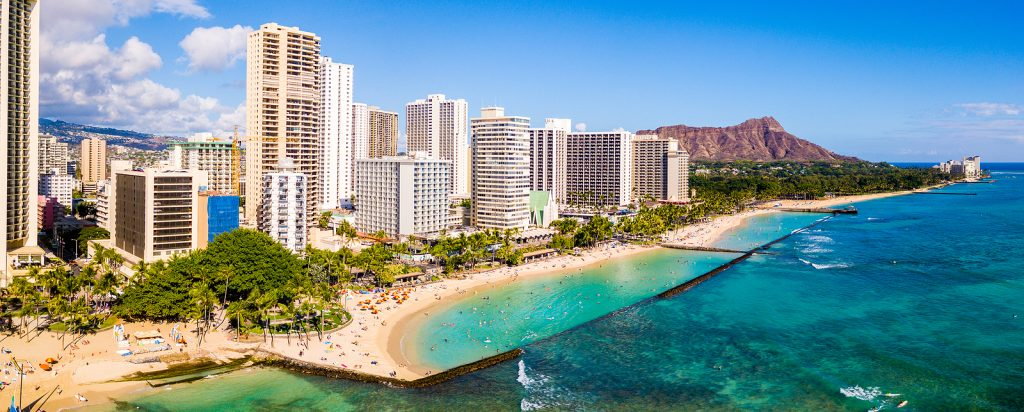
Add Your Heading Text Here
Waikiki, a world-renowned neighborhood in Honolulu, is more than just a destination; it's a vibrant celebration of Hawaii's natural beauty, culture, and modern allure. Nestled along Oahu's southern coast, Waikiki is where the pristine waters of the Pacific meet iconic urban energy. With its golden beaches, storied history, and dynamic atmosphere, Waikiki has become a symbol of paradise for visitors from around the globe while maintaining its significance in Hawaiian culture and heritage.
Long before Waikiki became a hub for travelers, it was a place of profound importance to the Native Hawaiian people. The name "waikiki" translates to "spouting waters," reflecting the streams and springs that once nourished its fertile land. In ancient times, it served as a royal retreat for Hawaiian ali'i (chiefs), who enjoyed the area's tranquil beauty and abundant resources. Taro fields, fishponds, and a network of freshwater streams sustained thriving communities, and the region was a center for recreation, including the early art of surfing.
Surfing, a sport deeply ingrained in Hawaiian culture, finds its roots in Waikiki. This legendary coastline is where Duke Kahanamoku, the"Father of Modern Surfing," honed his skills and introduced the world to the joys of riding waves. Today, the gentle breaks of Waikiki Beach remain a haven for surfers of all levels, drawing both seasoned wave riders and first-time learners eager to connect with Hawaii's surfing legacy.
As visitors step onto Waikiki's sands, they are greeted by a stunning juxtaposition of natural beauty and urban sophistication. The crescent-shaped shoreline is framed by the iconic silhouette of Diamond Head, a volcanic tuff cone that serves as a striking backdrop to the beach's turquoise waters. The soft sands stretch for miles, inviting sunbathers, swimmers, and beachcombers to relax and soak up the tropical atmosphere.
Beyond the beach, Waikiki pulses with energy, offering a dynamic blend of shopping, dining, and entertainment. Kalakaua Avenue, the main thoroughfare, is a bustling strip lined with luxury boutiques, local craft shops, and international brands. Restaurants showcase a fusion of global cuisines with a distinctly Hawaiian twist, from fresh poke bowls and kalua pork to gourmet seafood and tropical cocktails.
Despite its modernity, Waikiki remains deeply connected to its cultural roots. Landmarks such as the statue of Duke Kahanamoku honor the area's rich history and the individuals who shaped its identity. Traditional Hawaiian music and hula performances are woven into the fabric of daily life, providing visitors with a window into the islands' rich traditions. Events like the Waikiki Hoolaulea and the Duke's OceanFest celebrate Hawaiian culture while inviting the global community to join in the festivities.
At night, Waikiki transforms into a dazzling spectacle. The sunsets paint the sky in hues of orange and pink, casting a warm glow over the water and the city lights. Street performers, torch-lit luaus, and beachfront fire shows create an ambiance that is both exciting and enchanting.
Waikiki is not merely a destination but a living tapestry where history, culture, and contemporary life converge. It is a place where the aloha spirit thrives, inviting everyone to experience the magic of Hawaii through its breathtaking landscapes, storied past, and vibrant energy. Whether catching a wave, strolling along the beach, or simply basking in the beauty of the Pacific, Waikiki offers an unforgettable journey into the heart of paradise.
Diamond Head
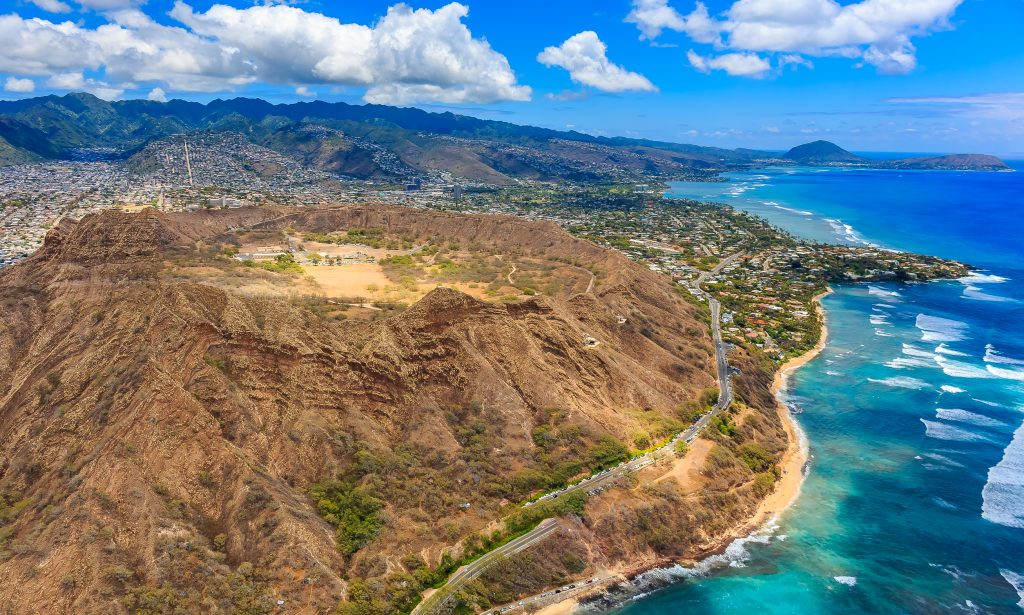
Diamond Head, known as Leahi in Hawaiian, is one of the most iconic landmarks in Hawaii and a symbol of Oahu's natural beauty and volcanic origins. Rising majestically on the southern shore of the island, this ancient volcanic tuff cone has become a destination that seamlessly blends natural wonder, cultural significance, and adventure. Its silhouette, visible from Waikiki Beach and beyond, serves as a dramatic reminder of Hawaii's geological past and its enduring allure.
The formation of Diamond Head dates back over 300,000 years, the result of a single explosive volcanic eruption. Ash and fine particles, carried high into the atmosphere, settled and solidified to form the cone that we see today. Unlike towering shield volcanoes like Mauna Loa, Diamond Head is part of the Honolulu Volcanic Series, a chain of smaller volcanic features created during the island's late-stage eruptions. Its unique crescent-shaped crater spans approximately 350 acres, making it one of the most recognizable volcanic formations in the Pacific. The Hawaiian name Leahi, which translates to "brow of the tuna," reflects the crater's resemblance to the dorsal fin of a tuna fish. This poetic connection to the ocean underscores the relationship between the island's natural features and the marine environment. The name Diamond Head emerged later, coined by 19th-century British sailors who mistakenly believed the glimmering calcite crystals embedded in the rocks were diamonds. While the crystals held no monetary value, the name endured, adding a layer of mystique to this geological wonder.
Diamond Head's historical significance extends beyond its geological origins. In the early 20th century, it was transformed into a strategic military outpost to defend the island from potential attacks. The United States military constructed bunkers, observation decks, and tunnels within the crater, remnants of which can still be explored today. During World War II, the summit served as a lookout point, providing a commanding view of the Pacific Ocean and Oahu's southern coastline. This military history adds depth to Diamond Head's story, blending natural history with human innovation and resilience.
For modern visitors, Diamond Head offers an unparalleled opportunity to connect with nature and history. The Diamond Head Summit Trail, a steep but rewarding hike, takes adventurers from the crater floor to the summit. Along the way, hikers traverse switchbacks, pass through tunnels, and climb a final set of stairs to reach the observation deck. At the summit, the reward is breathtaking: panoramic views of Waikiki's glittering skyline, the turquoise waters of the Pacific, and the verdant hills of Oahu's interior.
Diamond Head is more than a natural landmark; it is a cultural treasure that embodies the spirit of Hawaii. For Native Hawaiians, Leahi has spiritual significance, and its slopes were historically used for religious ceremonies and agriculture. Today, its trails and vistas provide a sanctuary for reflection and exploration, drawing thousands of visitors each year who seek to experience its enduring magic.
Whether viewed from afar or explored up close, Diamond Head captivates all who encounter it. Its rugged beauty, storied past, and commanding presence make it a symbol of Hawaii's resilience, creativity, and timeless connection to the natural world.
Chinaman's Hat
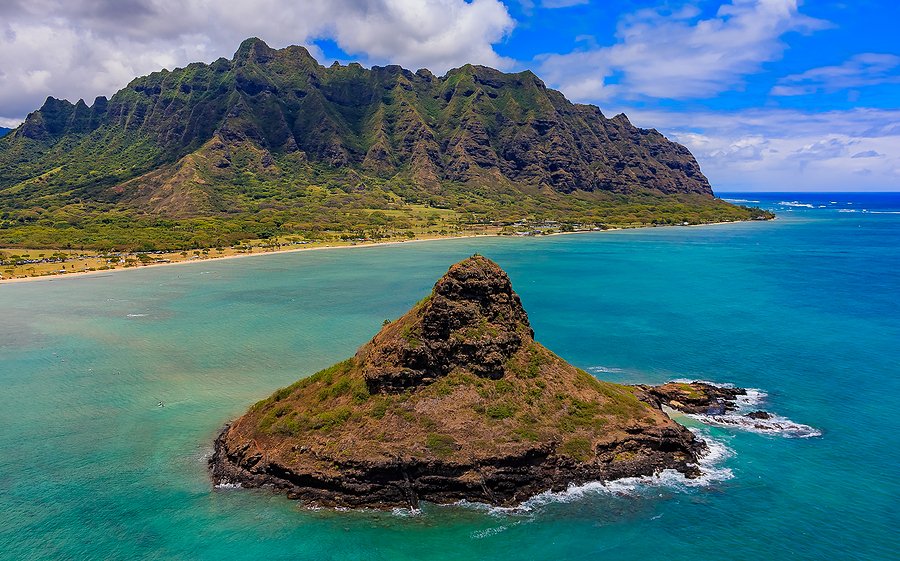
Add Your Heading Text Here
Mokoli'i, affectionately known as "Chinaman's Hat," is one of Oahu's most distinctive landmarks. Located off the northeastern shore near Kualoa Regional Park, this small island is steeped in natural beauty, Hawaiian legend, and cultural significance. Its conical shape, resembling the traditional woven hats worn by Chinese laborers in Hawaii, gives Mokoli'i its popular nickname. However, the island's original name, Mokoli'i, holds deeper meaning in Hawaiian mythology and speaks to its enduring connection to the land and sea.
According to Hawaiian legend, Mokoli'i is said to be the remnant of a great lizard, or mo'o, that once terrorized the people of the area. The demigod Hi'iaka, sister of the volcano goddess Pele, defeated the creature in a fierce battle, scattering its body across the bay. Mokoli'i represents the lizard's tail, left to stand as a symbol of Hi'iaka's triumph and the strength of the Hawaiian people. This tale not only adds mystique to the island but also reflects the deep spiritual ties that Native Hawaiians have with their surroundings.
Mokoli'i's unique geological formation is a result of volcanic activity millions of years ago, when molten lava met the ocean and solidified into the basaltic rock that now forms the island. Standing just over 200 feet tall, Mokoli'i rises dramatically from the turquoise waters of Kaneohe Bay, creating a striking contrast against the verdant Ko'olau Mountain Range in the background. This picturesque setting has made Mokoli'i a favorite subject for photographers and a symbol of Oahu's breathtaking natural beauty.
For adventurers, Mokoli'i offers an unforgettable experience. During low tide, visitors can walk or kayak across the shallow waters to the island, making the journey an adventure in itself. Upon arrival, those who seek a challenge can climb the steep, rocky path to Mokoli'i's summit. Though the ascent requires caution and a good pair of shoes, the panoramic views from the top are unparalleled. From this vantage point, one can see the expansive Kaneohe Bay, the nearby Mokapu Peninsula, and the lush greenery of Oahu's windward coast.
The waters surrounding Mokoli'i are equally captivating. Teeming with marine life, they provide excellent opportunities for snorkeling and kayaking. The coral reefs and sandy sea floor create a vibrant underwater ecosystem where fish, sea turtles, and other marine creatures thrive. The area's calm waters make it an ideal spot for both seasoned paddlers and beginners looking to explore Hawaii's coastal treasures.
Mokoli'i also holds cultural significance as part of the greater Kualoa area, which is considered sacred land in Hawaiian tradition. Kualoa was once a place of learning for Hawaiian chiefs and a site for religious ceremonies. The proximity of Mokoli'i to this revered area underscores its role in the cultural and spiritual landscape of Oahu.
Today, Mokoli'i stands as a symbol of the island's natural and cultural heritage, drawing visitors who seek to connect with its beauty and stories. Whether admired from the shore, explored on foot, or circled by kayak, Mokoli'i captures the imagination and leaves an indelible impression on all who encounter it. Its enduring presence is a reminder of the harmony between Hawaii's land, sea, and history, and the timeless allure of the islands.
North Shore Garlic Shrimp
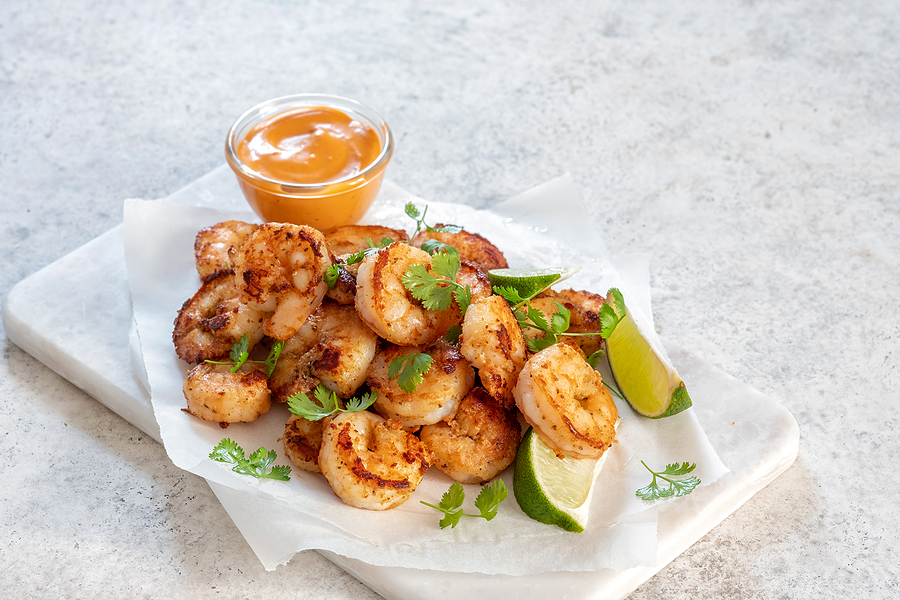
Add Your Heading Text Here
On Oahu's famed North Shore, garlic shrimp is more than just a dish—it's a culinary experience that captures the essence of island life. From roadside shrimp trucks to local eateries, this savory treat has become a must-try for visitors and a beloved staple for residents. Known for its bold flavors, fresh ingredients, and unpretentious presentation, North Shore garlic shrimp embodies the spirit of Hawaii's food culture: simple, authentic, and packed with aloha.
The roots of garlic shrimp on the North Shore can be traced to the area's shrimp farms, which thrive in the brackish waters of Kahuku. These farms produce some of the freshest shrimp in Hawaii, ensuring that the dish is as locally sourced as it is delicious. What began as a practical way to showcase the abundance of fresh shrimp has evolved into a culinary phenomenon, drawing food enthusiasts from around the globe.
The star of the dish is, of course, the shrimp—juicy, tender, and cooked to perfection. The preparation is straightforward yet deeply satisfying: shrimp are sautéed in a generous amount of butter, infused with minced garlic, and seasoned with salt, pepper, and occasionally a hint of lemon or chili for extra flair. The result is a rich, aromatic flavor that clings to the shrimp's shell, encouraging diners to dig in with their hands for the full experience.
Accompanying the shrimp is a side of fluffy white rice, often drizzled with the buttery garlic sauce for added indulgence. Some variations include a scoop of creamy macaroni salad, a nod to Hawaii's plate lunch tradition. Others might add fresh greens, pineapple slices, or pickled vegetables to complement the dish's robust flavors. No matter the accompaniments, the shrimp always take center stage, and the simplicity of the dish allows the quality of the ingredients to shine.
The best way to enjoy North Shore garlic shrimp is from one of the iconic food trucks that line the coastal roads. Trucks like Giovanni's, Romy's, and Fumi's have earned legendary status, each offering its own spin on the classic recipe. The trucks, often adorned with graffiti and surrounded by picnic tables, create a laid-back atmosphere where diners can savor their meal under the shade of palm trees with ocean breezes in the air. It's an experience that feels uniquely Hawaiian, blending culinary delight with the island's natural beauty.
What sets North Shore garlic shrimp apart isn't just the taste but the way it brings people together. Locals and tourists alike gather around the food trucks, sharing stories, recommendations, and laughter over plates of buttery shrimp. The dish has become a symbol of the North Shore's welcoming vibe and its fusion of local traditions with global influences.
North Shore garlic shrimp is more than a meal—it's a celebration of Hawaii's flavors and lifestyle. With every bite, diners taste the freshness of the ocean, the warmth of the islands, and the creativity of a community that turns the simplest ingredients into unforgettable moments. Whether it's your first time or a regular indulgence, garlic shrimp on the North Shore leaves a lasting impression that lingers long after the plate is empty.
North Shore Surfing
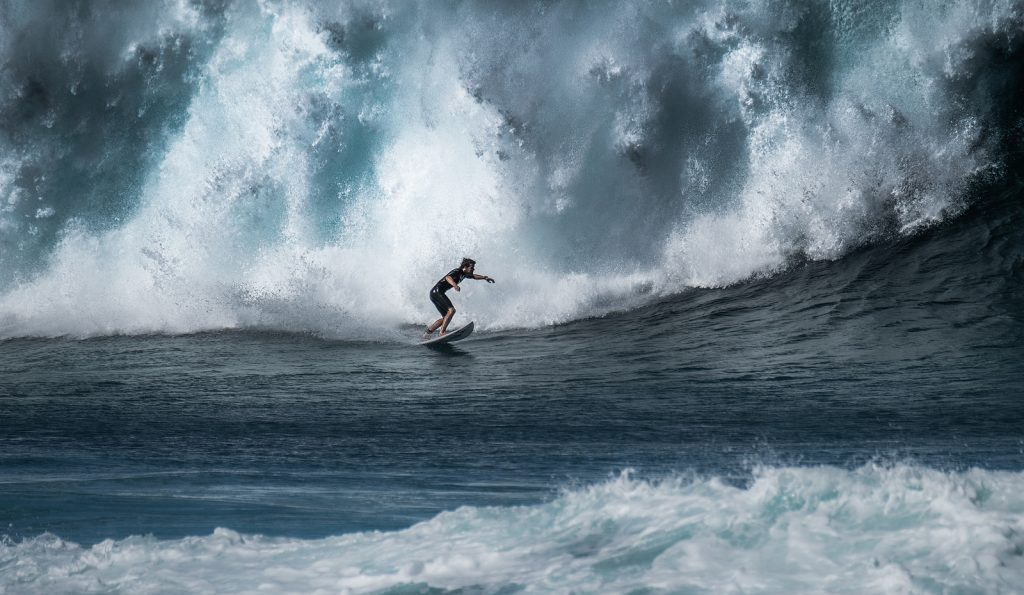
Add Your Heading Text Here
North Shore surfing is more than a sport—it's a way of life, an art form, and a testament to the raw power of nature. Stretching along Oahu's northern coastline, the North Shore is a globally renowned surfing mecca that attracts wave riders from every corner of the planet. With its towering winter swells, legendary breaks, and rich cultural history, this stretch of coastline is the heartbeat of the surfing world and a stage where the ocean's power meets human skill.
The North Shore's reputation as a surfing paradise stems from its unique geography. The open expanse of the Pacific Ocean funnels energy from distant storms, creating massive, perfectly formed waves that roll toward the shore during the winter months. From October to April, waves can reach heights of 30 feet or more, transforming the tranquil summer beaches into a playground for professional surfers and a spectacle for eager spectators.
Famous breaks like Waimea Bay, Pipeline (Banzai Pipeline), and Sunset Beach have become synonymous with the North Shore's prestige. Waimea Bay holds a special place in surfing history as the birthplace of big-wave surfing. In the 1950s, fearless pioneers like Eddie Aikau paddled out into its massive waves, redefining what was possible on a surfboard. Today, the Eddie Aikau Big Wave Invitational, held only when waves reach a minimum of 20 feet, honors Eddie's legacy and showcases the best big-wave surfers in the world.
Pipeline, often referred to simply as "Pipe," is the crown jewel of the North Shore. Known for its perfect but perilous barrels, Pipeline offers one of the most challenging rides in the surfing world. The wave breaks over a shallow coral reef, creating a hollow tube that surfers attempt to ride from start to finish. It's a test of precision, courage, and mastery, and only the most skilled surfers can tackle its formidable walls of water. For those who succeed, a perfect ride at Pipeline is considered the pinnacle of surfing achievement.
Sunset Beach, with its long, powerful waves, is another iconic spot that tests surfers' stamina and adaptability. It's a venue for prestigious competitions like the Vans Triple Crown of Surfing, which solidifies the North Shore as the ultimate proving ground for surfers.
For spectators, the North Shore offers a front-row seat to some of the most exhilarating surfing in the world. The energy is palpable as crowds gather on the beaches to watch athletes carve through walls of water and disappear into the barrels of colossal waves. Photographers, journalists, and fans from around the globe flock to these shores, creating an atmosphere that feels as much like a festival as it does a sporting event.
Beyond the competitive scene, the North Shore represents the soul of surfing. It's a place where the culture thrives, from local shapers crafting custom boards to surf schools teaching newcomers how to ride their first wave. The spirit of aloha infuses every aspect of North Shore surfing, emphasizing respect for the ocean, the community, and the history of the sport.
Whether you're a seasoned professional, a casual enthusiast, or simply an admirer of the ocean's majesty, the North Shore offers an unparalleled experience. Its waves are more than just water in motion—they're forces of natural challenges, inspires, and connects all who encounter them. Surfing the North Shore isn't just about conquering waves; it's about embracing the essence of Hawaii's culture and the profound connection between people and the sea.
Waimea Bay
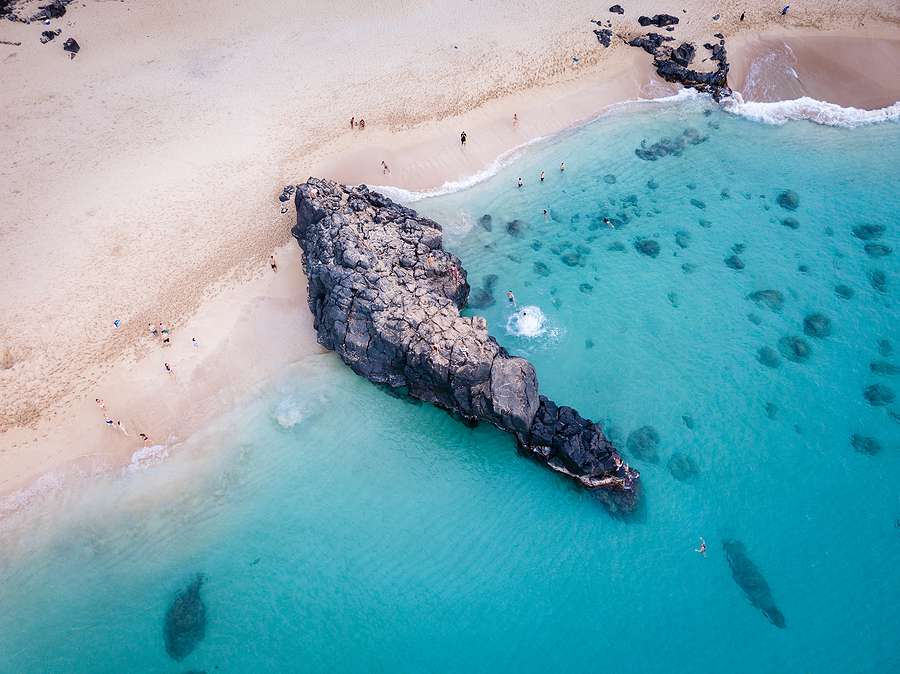
Waimea Bay Beach Park with divers jumping off cliff into clear turquoise water. Oahu, Hawaii, north shore.
Lorem ipsum dolor sit amet, consectetur adipiscing elit. Ut elit tellus, luctus nec ullamcorper mattis, pulvinar dapibus leo.Lorem ipsum dolor sit amet, consectetur adipiscing elit. Ut elit tellus, luctus nec ullamcorper mattis, pulvinar dapibus leo.Lorem ipsum dolor sit amet, consectetur adipiscing elit. Ut elit tellus, luctus nec ullamcorper mattis, pulvinar dapibus leo.Lorem ipsum dolor sit amet, consectetur adipiscing elit. Ut elit tellus, luctus nec ullamcorper mattis, pulvinar dapibus leo.Lorem ipsum dolor sit amet, consectetur adipiscing elit. Ut elit tellus, luctus nec ullamcorper mattis, pulvinar dapibus leo.
Dole Plantation
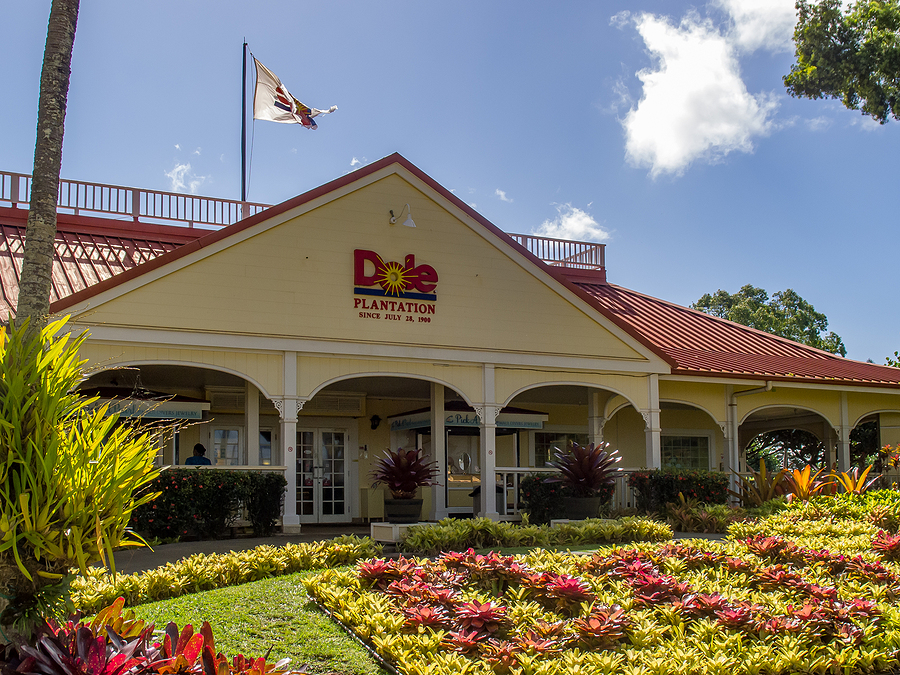
Add Your Heading Text Here
The Dole Plantation, located on Oahu's central plains near Wahiawa, is more than just a visitor attraction—it's a living testament to Hawaii's agricultural heritage and its global influence as a producer of one of the world's most beloved fruits: the pineapple. Once a thriving epicenter of pineapple production, the plantation today is a vibrant destination that invites visitors to explore the history, culture, and natural beauty of Hawaii through the lens of this iconic crop.
The story of the Dole Plantation begins in 1899, when a young Massachusetts native named James Drummond Dole arrived in Hawaii with a vision. Dole saw the potential of Hawaii's fertile volcanic soil and ideal growing conditions and established the Hawaiian Pineapple Company, which would later become the globally recognized Dole Food Company. By pioneering large-scale pineapple farming and canning techniques, Dole helped transform Hawaii into the "Pineapple Capital of the World" in the early 20th century.
At the heart of the Dole Plantation experience is its celebration of the pineapple, a fruit that has become synonymous with Hawaii's identity. Visitors are welcomed into a world where the golden fruit takes center stage, from educational exhibits detailing its cultivation and history to interactive experiences that immerse guests in the agricultural traditions of the islands.
One of the plantation's highlights is the Pineapple Express, a charming train ride that takes visitors through the sprawling fields of pineapples, tropical flowers, and other crops. Along the way, the narration shares fascinating insights into the plantation's operations, the life cycle of the pineapple, and the history of agriculture in Hawaii. It's a journey that combines scenic beauty with storytelling, offering a glimpse into the labor and innovation that made pineapple a cornerstone of Hawaii's economy.
The Plantation Garden Tour is another must-see, allowing guests to wander through meticulously maintained gardens showcasing the island's diverse flora. From lush tropical blooms to exotic fruit trees, the gardens highlight the abundance of Hawaii's natural resources while providing a serene escape for visitors to enjoy.
For those seeking a challenge, the Pineapple Garden Maze offers a playful and engaging adventure. Recognized as one of the world's largest mazes, it invites guests to navigate through intricate pathways lined with thousands of Hawaiian plants. Completing the maze is not only a test of navigation skills but also an opportunity to immerse oneself in the plantation's unique charm.
No visit to the Dole Plantation would be complete without indulging in its culinary offerings. The famous Dole Whip, a creamy and refreshing pineapple soft-serve treat, is a favorite among locals and visitors alike. The plantation's cafe and store also offer pineapple-inspired dishes, souvenirs, and fresh pineapples to take home, ensuring that the flavors of Hawaii linger long after the visit ends.
While the Dole Plantation is a celebration of all things pineapple, it also serves as a reminder of Hawaii's agricultural history and the contributions of the workers who cultivated its fields. It honors the legacy of those who toiled to make Hawaii a global leader in pineapple production and offers a space where history, culture, and enjoyment come together.
The Dole Plantation is more than just a destination; it's a sensory journey through the heart of Hawaii's agricultural story. With its lush landscapes, interactive experiences, and iconic flavors, it offers a unique opportunity to connect with the islands' rich heritage while enjoying a taste of paradise.
Ask A Question About Private Oahu Customized Tour
Choose and Book Your Preferred Tour From
Daniel K. Inouye International Airport (Honolulu airport)
Bold text uspendisse lobortis aliquam lacus, vitae lacinia purus viverra vitae. Nulla facilisi. Duis efficitur, neque id egestas blandit, arcu lorem commodo justo, non aliquam arcu nulla et libero. Link inside text, massa quis molestie venenatis, erat enim faucibus sapien, eget elementum risus sapien vel turpis. Fusce vestibulum suscipit sem, vel gravida neque maximus ut. Duis dignissim enim at lorem auctor consequat. Ut neque dui, dapibus nec molestie quis, facilisis nec odio. Proin faucibus sodales tincidunt. Proin a gravida mauris. Nam bibendum rutrum blandit. In sit amet ornare erat. Curabitur nec diam sit amet eros gravida mollis. Vestibulum in lectus venenatis, tempor mauris et, malesuada nulla.
Private Pearl Harbor Memorial Tours
Daniel K. Inouye International Airport
